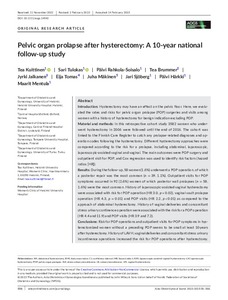Pelvic organ prolapse after hysterectomy: A 10-year national follow-up study
Mäkinen Juha; Harkki Päivi; Jalkanen Jyrki; Rahkola-Soisalo Päivi; Brummer Tea; Kuittinen Tea; Sjöberg Jari; Mentula Maarit; Tulokas Sari; Tomas Eija
https://urn.fi/URN:NBN:fi-fe2023052447271
Tiivistelmä
Introduction: Hysterectomy may have an effect on the pelvic floor. Here, we evaluated the rates and risks for pelvic organ prolapse (POP) surgeries and visits among women with a history of hysterectomy for benign indication excluding POP.
Material and methods: In this retrospective cohort study 3582 women who underwent hysterectomy in 2006 were followed until the end of 2016. The cohort was linked to the Finnish Care Register to catch any prolapse-related diagnoses and operation codes following the hysterectomy. Different hysterectomy approaches were compared according to the risk for a prolapse, including abdominal, laparoscopic, laparoscopic-assisted vaginal and vaginal. The main outcomes were POP surgery and outpatient visit for POP, and Cox regression was used to identify risk factors (hazard ratios [HR]).
Results: During the follow-up, 58 women (1.6%) underwent a POP operation, of which a posterior repair was the most common (n = 39, 1.1%). Outpatient visits for POP symptoms occurred in 92 (2.6%) women of which posterior wall prolapses (n = 58, 1.6%) were the most common. History of laparoscopic-assisted vaginal hysterectomy were associated with risk for POP operation (HR 3.0, p = 0.02), vaginal vault prolapse operation (HR 4.3, p = 0.01) and POP visits (HR 2.2, p < 0.01) as compared to the approach of abdominal hysterectomy. History of vaginal deliveries and concomitant stress urinary continence operation were associated with the risk for a POP operation (HR 4.4 and 11.9) and POP visits (HR 3.9 and 7.2).
Conclusions: Risk for POP operations and outpatient visits for POP symptoms in hysterectomized women without a preceding POP seems to be small at least 10 years after hysterectomy. History of LAVH, vaginal deliveries and concomitant stress urinary incontinence operations increased the risk for POP operations after hysterectomy. These data can be utilized in counseling women considering hysterectomy for benign indication.
Kokoelmat
- Rinnakkaistallenteet [19207]
